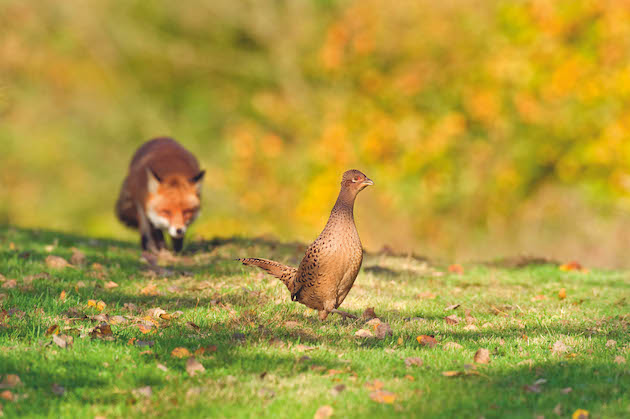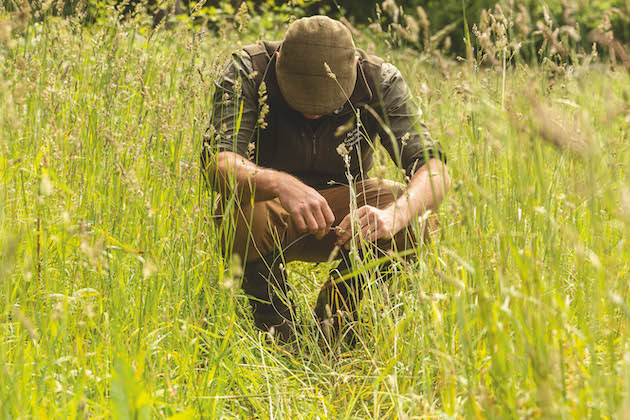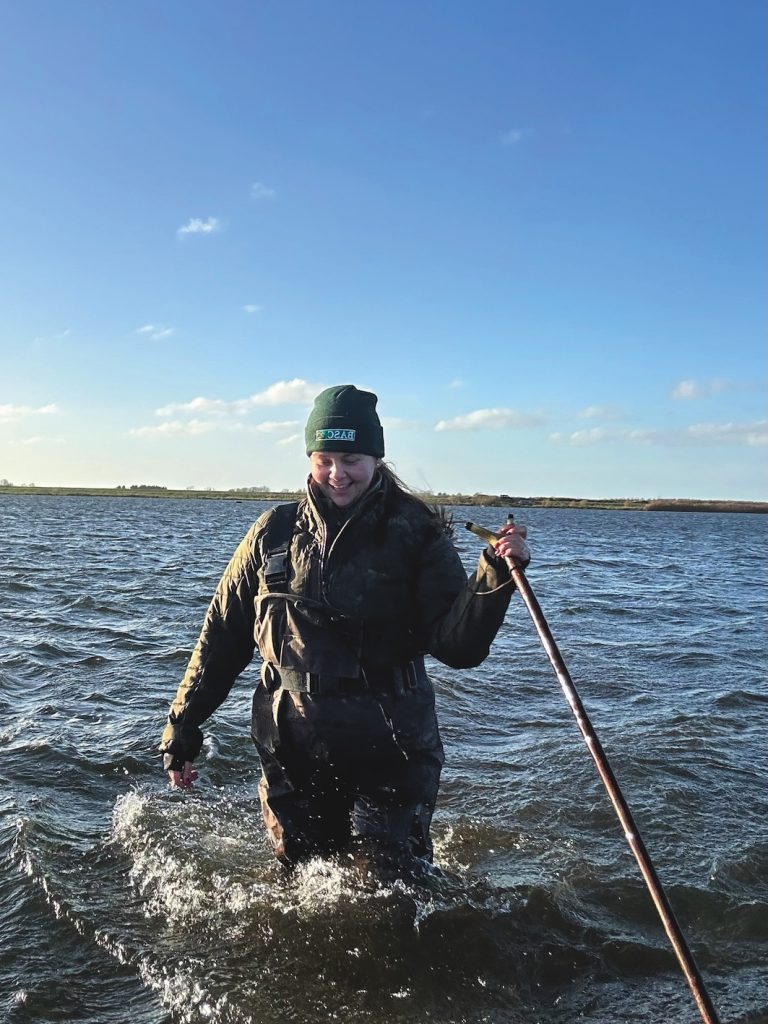Win CENS ProFlex DX5 earplugs worth £1,149 – enter here
Using traps and snares: how to do it legally and effectively
 C1E0N6 Red fox (Vulpes vulpes), North Downs, Kent, UK. Stalking pheasant
C1E0N6 Red fox (Vulpes vulpes), North Downs, Kent, UK. Stalking pheasant
Traps and snares play a vital role in gamekeeping. If you are looking to establish new ground for a shoot or simply increase the amount of wild game in your area, knowing how and when to trap is essential. Whether you’re using cages or tunnels to reduce predation, Larsen trapping to protect red-listed birds or snaring to control fox numbers, it’s important that keepers take a broad view of their end goals. For those taking on new ground, successful early trapping will lay the foundations for a prosperous shoot in the year to come.
Almost as soon as the season ends, attention turns to next year’s pheasants and partridges. And it is an ideal time to start implementing a trapping plan. Foxes are paired up and mating, with cubs emerging from mid-February. Small mammals, meanwhile, are a constant danger to eggs and chicks alike, and opportunist hunters such as grey squirrels and rats can cause untold damage to wild stocks, especially in the spring. The harm they cause is harder to spot and their trapping more labour intensive, which is why controlling them is often overlooked.
The DOC trap was developed in New Zealand and is a good alternative to the Fenn Mark4 for stoats
Regulations on traps and snares
Setting and running a line of tunnel and rail traps does take time, but it will pay dividends later on when there are birds nesting in the hedge bottoms and chicks running about in the field margins. Until recently, the Fenn Mark4 — which was the preferred trap of every keeper I know — was legal to trap stoats, weasels, rats and grey squirrels. Now, due to international trapping regulations, they can no longer be used to trap stoats.
Thankfully, there are licensed alternatives, such as the Tully trap, the DOC trap (which was developed in New Zealand for catching non-native possums) and the Perdix trap. All three can be set in much the same way as the Fenn traps can, though there are legal requirements relating to the use of excluders for those who use the DOC. Regardless of which you choose, something we have to do as a sector is remain legal and above board.
Foxes pose another issue, not only in spring, when they will take hens off the nests and eat every egg they find, but also later on in the year when they are hunting around release pens and cover crops. The use of thermal-imaging equipment and image intensifiers has changed the way a lot of our fox control is carried out, but when the cover is up and tall enough to hide any number of foxes and well-grown cubs, the only real way to control them is to use snares.

Gamekeepers need to make sure they follow the code of good snaring practice to the letter
Snaring
The modern fox snare is far removed from the garrotting device of the late 1950s, which was developed to replace the now quite rightly illegal gin trap. Modern snaring devices have more in common with the cable restraints used by animal charities and the emergency services to catch and restrain injured or dangerous animals than they do with the crude wire nooses of yesteryear.
Moves are already afoot in Wales to ban snares — and restraining devices — and with things being far from stable in the other parts of the UK, none of us should become complacent. Each and every one of us needs to book on to a one-day GWCT snaring course, we need to make sure we follow the code of good snaring practice to the letter and only use modern break-away snares. If we are not trained, if we don’t follow the code and if we continue to use non-code-compliant snares, we will only have ourselves to blame if snaring gets banned.
The modern break-away snare has more swivels than the old-type snares, so there is less risk of an animal twisting the wire and injuring itself. They have a break-away clip that will separate under pressure and, by doing so, allow non-target species to escape. And they have a fixed ‘stop’ clip on the wire, which prevents the noose from overtightening. The closed loop is small enough to hold a fox, but not so small that it is injured.
Those of you who have been unable to source the new code-compliant snares might want to get in touch with Perdix Wildlife Supplies — which also makes the new Perdix mammal trap — or Collins Nets.
Corvids
Corvids, much like stoats, weasels and rats, will take every opportunity they can to predate eggs and chicks. You can control them to protect the eggs and chicks of red-listed birds — including the grey partridge — under general licence GL40, but it is illegal to control them solely to protect the eggs and chicks of pheasants and red-legged partridges.
If you do have a legitimate reason for trapping corvids, it is best to get rid of them as soon as possible. The introduction of Larsen traps to the UK, some 30 years ago, has undeniably revolutionised their control and the basic design is much the same as it was when they were first licensed for use. But there have been a few useful modifications since.
The older ones were simple wooden frames with wire attached. They had two trapping compartments, which were accessible from the top, and a separate compartment for the call bird. They worked well for magpies, as they seem to prefer entering traps from above, but weren’t so good for crows, which prefer walking in at ground level.
The ones we use here at home — to protect our grey partridges and breeding waders — both have side and top entries and are made of green weldmesh panels. This makes them less conspicuous when set — and a lot lighter to carry. There are also some good round ones made by Solway Feeders.
Crows tend to prefer a trap set in a semi-open area that they can overfly and have a good look at before walking in for a closer look. For magpies, a trap that is partly hidden in a thicket or a patch of scrub works best. Traps should obviously be set away from public rights of way and prying eyes and, because we have a duty of care to the call birds, they need looking after properly.
They need shelter from the elements — something that should be incorporated into the design of the trap — a perch, food and fresh, clean water. Food wise, we feed our call birds dried dog food. We do this for a number of reasons, and not only because it is easier. First, any uneaten food stays fresher for longer. Secondly, dog food doesn’t attract non-target species like offal or carcasses will. And thirdly, it makes keeping the trap clean much easier. This is important as there have been several cases of people being taken to court for neglect of their call birds.
Equally important is the provision of fresh, clean water. Open water trays that the birds can defecate in are not good enough, nor, in my opinion, are cut-up milk cartons and plastic trays with homemade lids, when you can buy a bunny bottle from your local pet shop for a couple of pounds. Members of the crow family are clever birds and take to the bottles straight away. The bottles look more professional if someone unexpectedly comes across the trap, and are easier to keep clean and replace if they get cracked or broken.
Trap label
I’d also suggest adding a label simply saying that it is a legal trap for predation control. Most people who vandalise traps, or who let call birds out, don’t know what the trap is for and simply see what they assume to be an illegally trapped bird. Admittedly, a label won’t make much difference if the person is intent on damaging the trap regardless, but in the majority of cases, a label explaining what the traps are and why we set them, coupled with a neat, clean and tidy cage, will make a difference. Since we started using them, we have had no traps vandalised and few call birds let out.
Not only will an effective trapping regime reduce the number of eggs, chicks, poults and adult birds you lose to predation, it will boost wild bird populations on your ground. Keep records of your efforts and stay up to date with any legislation changes, and your hard work will soon be rewarded.
Related Articles
Get the latest news delivered direct to your door
Subscribe to Shooting Times & Country
Discover the ultimate companion for field sports enthusiasts with Shooting Times & Country Magazine, the UK’s leading weekly publication that has been at the forefront of shooting culture since 1882. Subscribers gain access to expert tips, comprehensive gear reviews, seasonal advice and a vibrant community of like-minded shooters.
Save on shop price when you subscribe with weekly issues featuring in-depth articles on gundog training, exclusive member offers and access to the digital back issue library. A Shooting Times & Country subscription is more than a magazine, don’t just read about the countryside; immerse yourself in its most authoritative and engaging publication.







